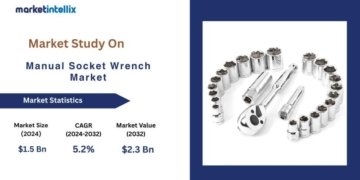The deep learning chipset market has emerged as one of the most dynamic sectors in the global technology landscape. This market is projected to grow at a remarkable Compound Annual Growth Rate (CAGR) of 27.1% from 2025 to 2032, reaching a valuation of approximately USD 36,040.9 million by 2032. In 2025, the market is expected to be valued at USD 6,726.3 million. This growth trajectory is being fueled by the widespread adoption of deep learning algorithms across various industries, including healthcare, automotive, aerospace, consumer electronics, and the rapidly expanding gaming sector.
The driving forces behind this growth are varied, ranging from the rising adoption of artificial intelligence (AI) and machine learning (ML) applications to the development of new, more efficient chipsets. AI is becoming increasingly integral to industries that require high computational power, such as robotics, data analytics, and cybersecurity. Additionally, the continuous expansion of smart homes, smart cities, and IoT devices further accelerates the demand for deep learning chipsets. These devices rely heavily on AI technologies, which in turn require high-performance chips that can handle complex tasks in real-time.
One of the key factors contributing to the market’s growth is the rapid advancement in cloud computing and the ever-increasing adoption of cloud-based AI services. In particular, the shift from traditional graphics processing units (GPUs) and central processors to specialized deep learning chipsets is enabling businesses to perform multiple complex tasks simultaneously, improving efficiency and reducing operational costs. These developments are transforming industries by reducing the need for human intervention and promoting automation, a trend that is driving the deep learning chipset market towards greater expansion.
✅Get a Sample Copy of Research Report (Use Corporate Mail id for Quick Response): https://www.persistencemarketresearch.com/samples/33373
Leading Market Segments and Regional Insights
Among the various market segments, the graphics processing units (GPU) segment holds a dominant position. GPUs are critical for deep learning tasks, such as image recognition, data processing, and machine learning, due to their parallel processing capabilities. They are expected to witness significant growth throughout the forecast period, fueled by the increasing demand for high-performance computing in fields like gaming, blockchain, and artificial intelligence.
Geographically, North America currently leads the global market and is anticipated to maintain its dominance. With a market size of USD 19.2 billion in 2023, North America’s deep learning chipset market is projected to reach USD 30 billion by 2032, growing at a CAGR of 41.3% during the forecast period. The United States, in particular, is seeing a surge in demand due to the widespread use of AI in industries such as healthcare, automotive, and consumer electronics. Smart home appliances in the region are another significant driver, with more than 40 million households in the U.S. already utilizing AI-based devices. By 2025, this number is expected to reach around 64 million, further boosting the need for deep learning chipsets.
Key Highlights from the Report
➤ The global deep learning chipset market is expected to grow at a CAGR of 27.1% from 2025 to 2032.
➤ North America is the leading region in the deep learning chipset market, with substantial growth projected through 2032.
➤ Graphics processing units (GPUs) remain the most widely used type of deep learning chip.
➤ The rise in smart homes and IoT applications is significantly boosting the demand for deep learning chipsets.
➤ The healthcare, automotive, and consumer electronics sectors are driving the market growth.
➤ Advancements in cloud computing and the growing reliance on AI are crucial factors driving demand.
Market Segmentation
The deep learning chipset market can be segmented based on product type, end-users, and applications. In terms of product type, the market is primarily divided into graphics processing units (GPUs), system-on-chip (SoC), and application-specific integrated circuits (ASICs). GPUs are expected to dominate the market due to their parallel processing capabilities, which make them ideal for deep learning tasks. These chips are used extensively in gaming, machine learning, and high-performance computing tasks, making them critical components in both personal and commercial applications. The GPU segment has seen consistent growth due to the rise in demand for gaming, cryptocurrency mining, and AI applications.
The system-on-chip (SoC) segment is also gaining traction, particularly in mobile devices, automotive applications, and consumer electronics. SoCs combine multiple components onto a single chip, including processors, memory, and network interfaces, providing a compact and energy-efficient solution for AI applications. These chips are especially useful in embedded systems and IoT devices, which are becoming increasingly popular in the consumer electronics market.
In terms of end-users, industries such as healthcare, automotive, aerospace & defense, and consumer electronics are the largest adopters of deep learning chipsets. In healthcare, AI-powered deep learning algorithms are being employed for medical imaging, drug discovery, and patient monitoring. Similarly, the automotive industry uses deep learning for autonomous vehicles and advanced driver-assistance systems (ADAS). The growing use of AI in robotics, cybersecurity, and virtual assistants is also contributing to the increasing demand for deep learning chips.
Regional Insights
Regionally, North America holds a dominant position in the deep learning chipset market, followed closely by Asia-Pacific. The United States is a key market driver in North America, primarily due to the significant advancements in AI and machine learning technologies. As businesses in the U.S. continue to adopt AI-powered solutions, particularly in industries like finance, healthcare, and manufacturing, the demand for deep learning chipsets will continue to rise. Moreover, the growth of smart home appliances and IoT devices is also contributing to the demand for these chips.
In Asia-Pacific, countries like China, Japan, and South Korea are seeing rapid growth in deep learning chipset demand. China, in particular, is expected to witness exponential growth, with an expected market size of USD 6.1 billion by 2032. The rising adoption of AI in industrial automation, coupled with the growing popularity of smart homes, is driving this expansion. South Korea is also becoming a significant hub for deep learning chipset production, driven by its tech-savvy population and increasing demand for smart appliances.
Market Drivers
The primary driver for the deep learning chipset market is the increasing reliance on artificial intelligence across various sectors. AI is being deployed in fields ranging from healthcare and automotive to finance and manufacturing, creating a massive demand for specialized chipsets. The use of deep learning algorithms in AI applications, such as natural language processing (NLP), image recognition, and predictive analytics, requires powerful processors capable of handling vast amounts of data.
Another key driver is the rise of smart homes and IoT devices. As the number of connected devices continues to grow, there is a growing need for high-performance chips that can process data in real time. Smart home appliances, such as thermostats, lights, and speakers, all rely on deep learning chipsets to function effectively, driving market growth.
Market Restraints
Despite its rapid growth, the deep learning chipset market faces several challenges. One of the primary restraints is the high cost associated with developing and manufacturing these advanced chips. The demand for custom-built deep learning chips tailored to specific applications often results in significant R&D investments, making it difficult for smaller players to enter the market. Additionally, the complex manufacturing processes involved in producing these chips can lead to longer production times and higher costs.
Another challenge is the growing concerns around data privacy and security. As deep learning algorithms require large datasets for training, ensuring the security and privacy of sensitive data becomes a critical issue. Regulatory challenges related to data protection laws and the ethical use of AI may pose obstacles to the widespread adoption of deep learning technologies in certain regions.
✅Request for Customization of the Research Report: https://www.persistencemarketresearch.com/request-customization/33373
Market Opportunities
The deep learning chipset market presents several opportunities for growth. The increasing demand for AI-powered applications, coupled with the rise of cloud computing and IoT devices, is expected to drive the need for more powerful chipsets. Companies that can develop energy-efficient and high-performance chips are likely to capitalize on this demand. Furthermore, the adoption of AI in emerging sectors such as healthcare, education, and agriculture presents untapped growth potential for deep learning chipset manufacturers.
Another significant opportunity lies in the burgeoning market for quantum computing. As quantum computing technology advances, it is expected to revolutionize deep learning algorithms, requiring even more advanced and specialized chipsets. Companies that invest in quantum computing and its integration with deep learning will likely be at the forefront of this next wave of innovation.
Frequently Asked Questions (FAQs)
➤ How Big is the Deep Learning Chipset Market?
➤ Who are the Key Players in the Global Market for Deep Learning Chipsets?
➤ What is the Projected Growth Rate of the Deep Learning Chipset Market?
➤ What is the Market Forecast for the Deep Learning Chipset Market for 2032?
➤ Which Region is estimated to dominate the Deep Learning Chipset Industry through the Forecast Period?
Company Insights
✦ Intel Corporation
✦ Nvidia Corporation
✦ Qualcomm Incorporated
✦ AMD (Advanced Micro Devices)
✦ Baidu, Inc.
✦ Samsung Electronics
✦ Alphabet Inc.
✦ Bitmain Technologies Ltd.
✦ Xilinx, Inc.
✦ Amazon.com, Inc.
Recent Developments
■ Intel launched its second-generation Habana AI deep learning processors in May 2022, offering improved efficiency and performance for AI applications.
■ IBM introduced the IBM Telum Processor in August 2021, designed for deep learning inference to handle real-time fraud detection and AI-based workloads.
By analyzing the deep learning chipset market’s current trends, key drivers, and challenges, this report provides essential insights for stakeholders looking to capitalize on this rapidly evolving sector.
Contact Us:
Persistence Market Research
G04 Golden Mile House, Clayponds Lane
Brentford, London, TW8 0GU UK
USA Phone: +1 646-878-6329
UK Phone: +44 203-837-5656
Email: sales@persistencemarketresearch.com
Web: https://www.persistencemarketresearch.com
About Persistence Market Research:
At Persistence Market Research, we specialize in creating research studies that serve as strategic tools for driving business growth. Established as a proprietary firm in 2012, we have evolved into a registered company in England and Wales in 2023 under the name Persistence Research & Consultancy Services Ltd. With a solid foundation, we have completed over 3600 custom and syndicate market research projects, and delivered more than 2700 projects for other leading market research companies’ clients.
Our approach combines traditional market research methods with modern tools to offer comprehensive research solutions. With a decade of experience, we pride ourselves on deriving actionable insights from data to help businesses stay ahead of the competition. Our client base spans multinational corporations, leading consulting firms, investment funds, and government departments. A significant portion of our sales comes from repeat clients, a testament to the value and trust we’ve built over the years.
This release was published on openPR.


















